Acupuncture Therapy
Trigger Point Acupuncture

Targeted Muscle Release & Pain Relief
Trigger Point Acupuncture is utilized to release a trigger point in the muscle or fascia and relieve pain. Multiple muscles may be released to improve the range and motion and stimulate tissue healing. This style of acupuncture is tailored for the active and/or pained individual.
Trigger point needling helps facilitate healing and recovery in stressed or injured muscles and fascia. It’s also often referred to as sports acupuncture since this style is greatly beneficial to those who are consistently physically active. If you have a nagging back or calf muscle that continually knots up after a workout or neck muscles that tighten at the end of a long work day then this is for you. We look at the interconnection of muscle groups as well as the neuromuscular relationship to determine the root cause of the pain. Trigger points refer to pain in other areas of the body while tight tender points cause dysfunction and pain in the muscle and joint, setting you up for further injury. Our acupuncturist, Caitlin Camisa, L.Ac., Dipl. Ac., determines the location of these trigger points and tight tender points, releases them and resets the neuromuscular relationship.
What is a Trigger Point?
Muscles are made up of thousands of tiny muscle fibers that expand and contract to move the muscle and joints. Over time, through overuse or injury some of these muscle fibers stop being able to expand and contract properly, leading to the classic muscle “knot.” Sometimes fascia (a layer of connective tissue) can form around the knot making it harder for the muscle to fire properly, and subsequently to fully relax. Having a trigger point in the muscle can be painful at the location of the trigger point and can cause pain to radiate to other areas, causing more dysfunction throughout the body.
Common Conditions Treated:
- Headaches
- Neck pain
- Shoulder pain
- Frozen shoulder
- Tennis/Golfer’s elbow
- Back Pain
- Hip pain
- Sciatica
- Bursitis
- Tendonitis
- Arthritis
- Pulled Hamstring
- Knee injuries
- Ankle injuries
- Plantar fasciitis
What Does This Therapy Involve?
Releasing trigger points involves inserting the acupuncture needle into this specific spot and manipulating it to elicit a “twitch response.” That contraction of the muscle triggers a reaction from the body’s own healing mechanisms, releasing histamines, which relax blood vessels and increase blood flow to the area. The muscle fibers relax, and the pain associated with the tightness begins to dissipate. Since overused muscles contract and shorten — something that can become chronic over time – getting the muscle to release is extremely beneficial while the body is recovering. It also reduces the strain on tendons and joints, further reducing the opportunity for a more serious injury. Caitlin will sometimes combine cupping therapy or electroacupuncture with trigger point needling.
What is Electroacupuncture?
Electroacupuncture, a modern variation, is the electrical stimulation applied to acupuncture needles to trigger a motor contraction. The ability to stimulate a motor twitch response with electricity is useful to trigger connective tissue remodeling and improve tissue plasticity.
What does electroacupuncture do?
- Restimulates the nervous system which reduces muscle motor inhibition caused by inflammation, stress, or injuries.
- Calms the stress response in the body, which allows improved blood flow to the injured tissues.
- Modulates the intensity of the nervous system response to injuries and stress.
- Calms the brain.
What are the clinical results of electroacupuncture?
- Improved ability to accurately contract the intended muscle.
- Improved endurance (the muscle can contract for longer).
- Improved active & passive range of motion.
- Better awareness of the muscle contracting.
- Exercise becomes easier to do.
- Increased strength.
How can muscles benefit from electrical stimulation?
Neuromotor inhibition occurs as a protective mechanism. This happens when there is inflammation, swelling, physical injury, or pain. It also occurs when a weak muscle works too hard for too long. This creates a cycle of a weak muscle becoming inhibited, which then makes it present weaker, causing dysfunction not only in those muscles, but the surrounding muscles and joints. Unless treated, the injury can persist into further injury and pain.
Acupuncture needles with electrical stimulation can physically reach these nerves that tell the muscles what to do. When you insert a needle close to a nerve, it modulates that pathway and resolves the neuromotor inhibition. That effect then travels up from the branch of that nerve to the spinal cord, up the spinal cord, and to the brain.
Any effect of acupuncture you can think of happens via the nervous system – the acupuncture needle acts as a gateway into the nervous system. Electroacupuncture better stimulates the nervous system and re-sets the neuromuscular relationship to enhance the communication between the nerves and the muscles.
What Should I Expect?
Prior to your first trigger point session, Caitlin will ask questions to determine the problem areas and will go over the process so that you understand exactly what will happen during the treatment. If appropriate, she might do some muscle testing to see which muscles are weak or tight. If you’ve already been assessed by one of our doctors of physical therapy, Caitlin works with the doctors to determine which muscles need releasing and re-setting to support your physical therapy. Otherwise, she will do a full comprehensive sports acupuncture evaluation to determine treatment. Electroacupuncture may be used in conjunction with trigger point needling, depending on the patient and their assessment.
There can be some initial soreness as the formerly knotted muscles relax and return to their normal length. However, you should notice the benefits within a few sessions, if not immediately, depending on the chronicity of your condition/injury.